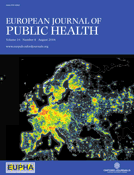-
PDF
- Split View
-
Views
-
Cite
Cite
Karl Andriessen, Do we need to be cautious in evaluating suicide statistics?, European Journal of Public Health, Volume 16, Issue 4, August 2006, Page 445, https://doi.org/10.1093/eurpub/ckl056
Close - Share Icon Share
Misclassifications result in under-reported official suicide data. Under-reporting varies across countries. Chishti1 looked at the 1984–98 mortality of suicide and undetermined causes in the European Union (EU) countries. Similar to suicide rates, undetermined causes were lowest in Mediterranean countries, and lowest in Greece. However, Portugal had the highest rate of undetermined causes, and only here this rate exceeded the suicide rate. Belgium, Germany, Ireland, and Spain had a significant neg-ative correlation between suicide rates and undetermined causes. Finland, Greece, The Netherlands, and Sweden had positive correlations, and no significant correlations in the remaining countries. The rates of suicide plus undetermined causes did not differ in the course of time, when compared with suicide rates, except in Spain where the 17% significant increase in suicide mortality (1984–98) decreased to only 8% with the combined rates.
Thus, ‘Misclassification appears to contribute to a minor proportion of the variation in suicide rates in the EU and does not explain it’ (p. 114). The authors pled for a EU standardized recording and certification procedure to safeguard international data comparability. Factors that currently may influence this include varying recording and classification systems (e.g. necessity of a suicide note, coroner investigation), socio-cultural norms (e.g. stigma, child suicide), recorded aspects (e.g. marital status, religion, occupation, social class), and varying confidentiality levels.
However, not all undetermined causes are hidden suicides. A recent study2 looked at the validity (true/false records) and reliability (stability of bias) of suicide data in France and the international comparability. Potentially influencing factors mentioned2 were varying certifiers' qualifications, frequency of medical/legal examinations/autopsies, different suicide definitions and levels of evidence, confidentiality regulations, and religious/cultural context. Death certificates of two ‘concurrent’ causes to suicide (violent deaths from undetermined intent and deaths from unknown causes) of 1998 from two regions were re-examined. A total of 35% of the undetermined category and 25% of the unknown causes were reclassified as suicides. Applying this under-reporting estimate to the national population of the 15–24 and the <65 years old, the corrected suicide mortality in the young increased with 21%, and with 23% in the <65 agegroup, with no gender differences. The 10% decrease of suicide mortality between 1980 and 1988 remained the same. Also the rank order of the different French regions was stable, but the interregional differences in suicide rates decreased from 9–27 to 15–30 owing to negative correlations between suicide data and data of unknown causes with respect to the regions.
Next, mortality data of 17 European countries were corrected with the same under-reporting estimates. After correction, only the rank order of Denmark and Portugal changed. The Danish suicide rate increased (19.8–31.9). But the suicide rate of Portuguese increased spectacularly (6.6–25.3), owing to very high rates of death from unknown causes or undetermined intent, a fact also observed by Chishti.1 However, the hamstring of this international com-parison is the assumption that the same percentages in the same concurrent categories would be found across countries, which needs confirmation from future studies. Indeed,1 the rates of undetermined causes varied considerably across countries and in the course of time, and both positive and negative correlations with suicide rates were observed. There is no standardized suicide certification across Europe and differences within countries exist as well.3,4 So it seems preliminary to already apply under-reporting estimates found in two regions in France to other countries.
Other potential limitations are that suicide could be misclassified in other categories, such as accidental deaths or illnesses (cancer,…), after drug overdoses, and when death occurs with a delay.3,4 In addition, data may be provider3 and classification system dependent.5 Caution is also needed when calculations are made on small populations,6 and national data may hide large local differences.7,8
Despite limitations, the total epidemiological picture seems to be reliable, and international suicide rates can be compared over time.2–5 Suicide data can have ‘a weak validity but an acceptable reliability’2 (p. 60).
With thanks to Prof. Diego De Leo, Mrs Jacinta Hawgood, and Dr Karolina Krysinska of the Masters of Suicidology, Australian Institute for Suicide Research and Prevention, Griffith University, Brisbane, Australia.
References
Chishti P, Stone D, Corcoran P, et al. Suicide mortality in the European Union.
Jougla E, Pequignot F, Chappert JL, et al. La qualité des données le mortalité sur de suicide (The quality of suicide mortality data).
De Leo D, Bertolote J, Lester D. Self-directed violence. In Krug E, Dahlberg L, Mercy J, Zwi A, Lozano R (eds), World Report on Violence and Health. Geneva: WHO,
Mathers C, Ma Fat D, Inoue M, et al. Counting the dead and what they died from: an assessment of the global status of cause of death data.
Pearson-Nelson B, Raffalovich L, Bjarnason T. The effects of changes in the World Health Organization's International Classification of Diseases on suicide rates in 71 countries, 1950–1999.
Bertolote J. Suicide in the world: an epidemiological overview, 1959–2000. In Wasserman D. (ed), Suicide, an Unnecessary Death. London: Martin Dunitz,
Neeleman J. Regional suicide rates in the Netherlands: does religion still play a role?.




Comments